Comprehensive Questions and Answers on the Islamic Faith
VerifiedAdded on 2022/08/12
|8
|1455
|14
Homework Assignment
AI Summary
This document presents a series of questions and answers on Islam, covering various aspects of the religion. It begins by defining Islam and the meaning of 'Muslim,' and then explores the interactions between the Prophet Muhammad and various tribes, including the Quraish and Jewish communities. The document highlights the Prophet's role in establishing women's rights and the significance of the Kaaba before and after Islam. It also discusses the importance of the year 622, marking the Hijra, and the establishment of a theocratic state in Medina. The document further delves into Quranic descriptions of the pre-creation heaven, prenatal development, and scientific facts. It outlines the five pillars of Islam, including the Shahada, Salah, Zakah, Sawm, and Hajj, and explores the concept of Jihad and its different connotations. The document also covers the core beliefs of Islam, such as the Oneness of Allah, belief in prophets, books, angels, the Day of Judgment, and Allah's knowledge. Finally, it touches upon the features of Islamic art, including calligraphy, geometric patterns, and figurative representation, and concludes with a list of cited works.
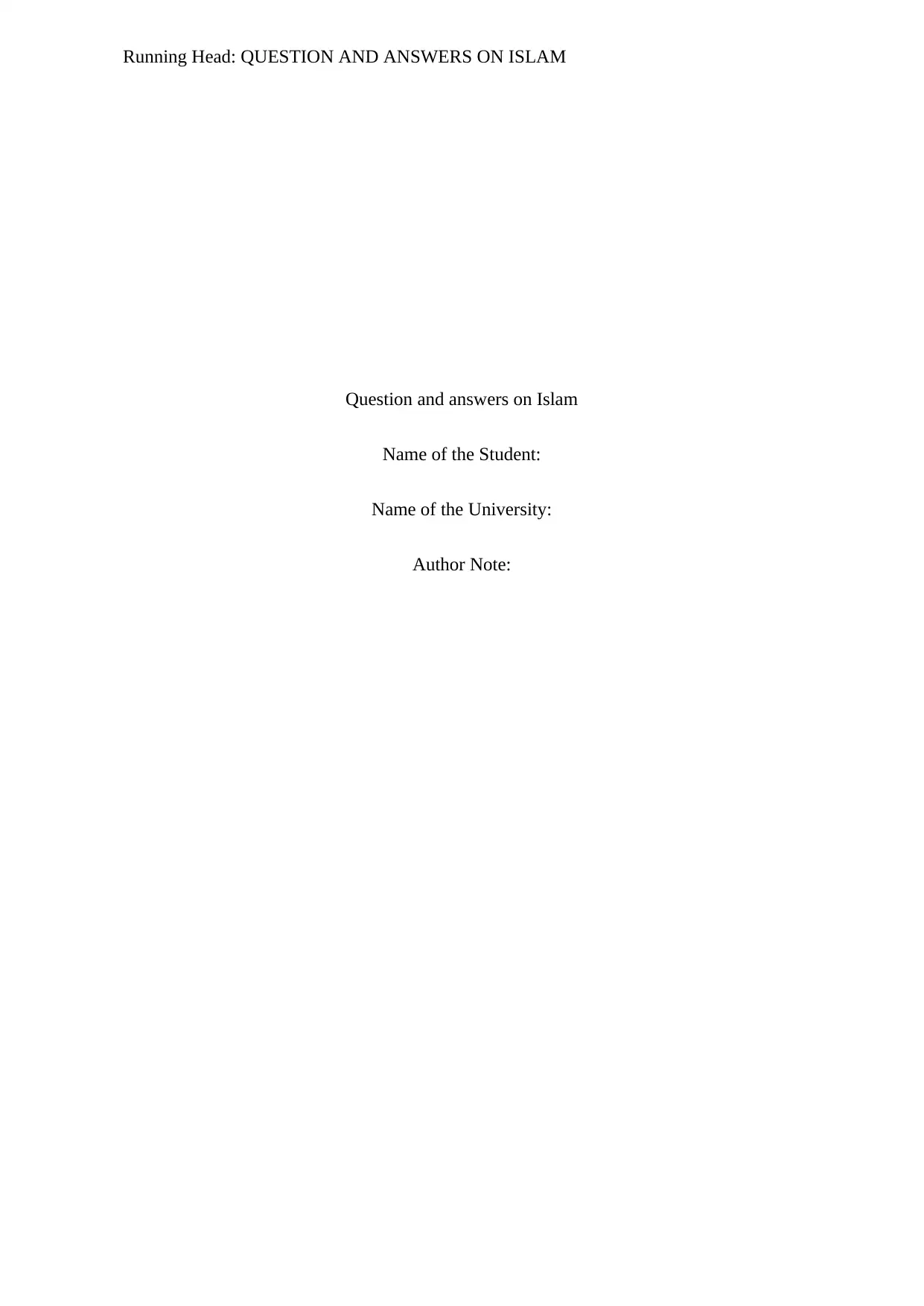
Running Head: QUESTION AND ANSWERS ON ISLAM
Question and answers on Islam
Name of the Student:
Name of the University:
Author Note:
Question and answers on Islam
Name of the Student:
Name of the University:
Author Note:
Paraphrase This Document
Need a fresh take? Get an instant paraphrase of this document with our AI Paraphraser
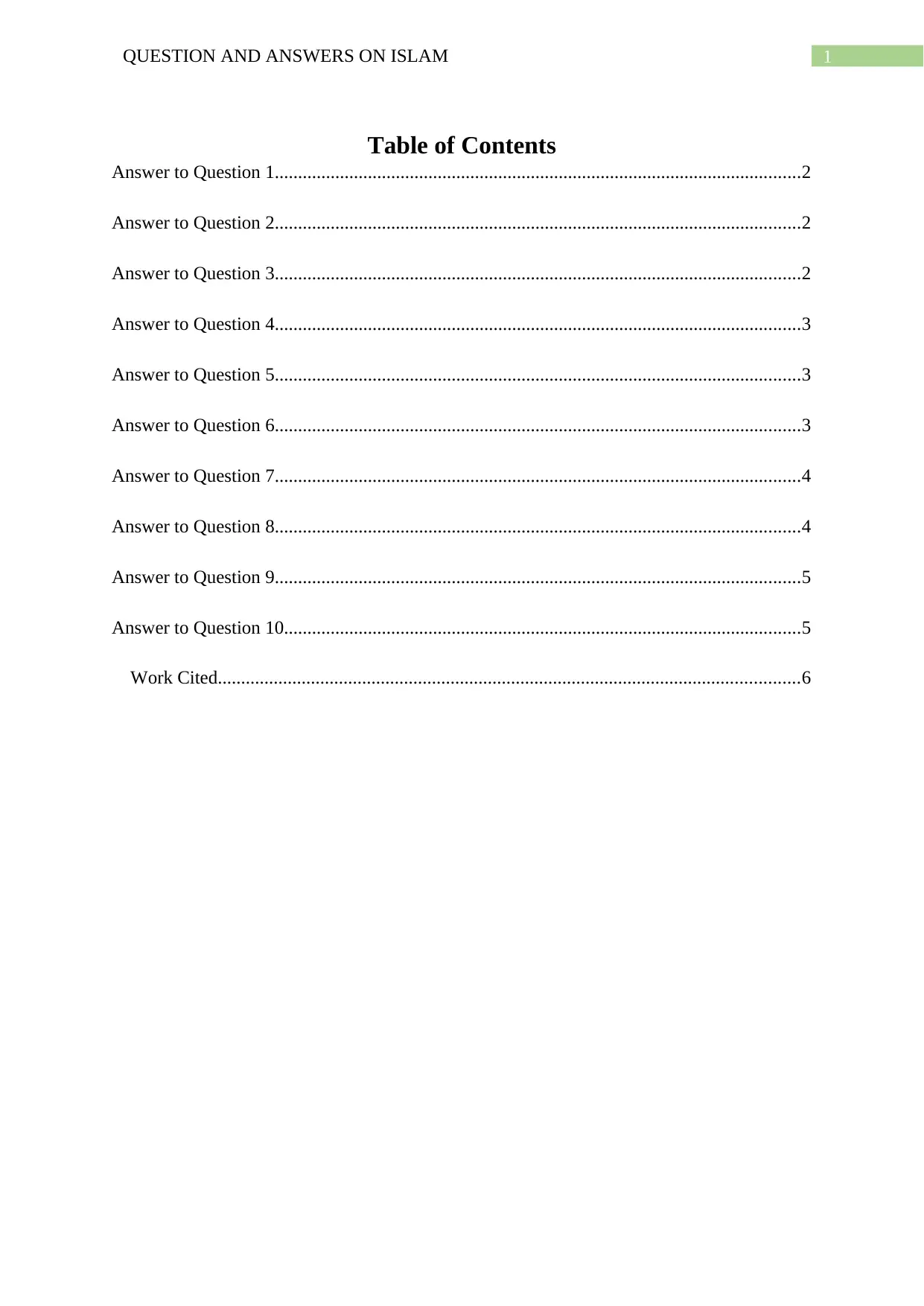
1QUESTION AND ANSWERS ON ISLAM
Table of Contents
Answer to Question 1.................................................................................................................2
Answer to Question 2.................................................................................................................2
Answer to Question 3.................................................................................................................2
Answer to Question 4.................................................................................................................3
Answer to Question 5.................................................................................................................3
Answer to Question 6.................................................................................................................3
Answer to Question 7.................................................................................................................4
Answer to Question 8.................................................................................................................4
Answer to Question 9.................................................................................................................5
Answer to Question 10...............................................................................................................5
Work Cited.............................................................................................................................6
Table of Contents
Answer to Question 1.................................................................................................................2
Answer to Question 2.................................................................................................................2
Answer to Question 3.................................................................................................................2
Answer to Question 4.................................................................................................................3
Answer to Question 5.................................................................................................................3
Answer to Question 6.................................................................................................................3
Answer to Question 7.................................................................................................................4
Answer to Question 8.................................................................................................................4
Answer to Question 9.................................................................................................................5
Answer to Question 10...............................................................................................................5
Work Cited.............................................................................................................................6
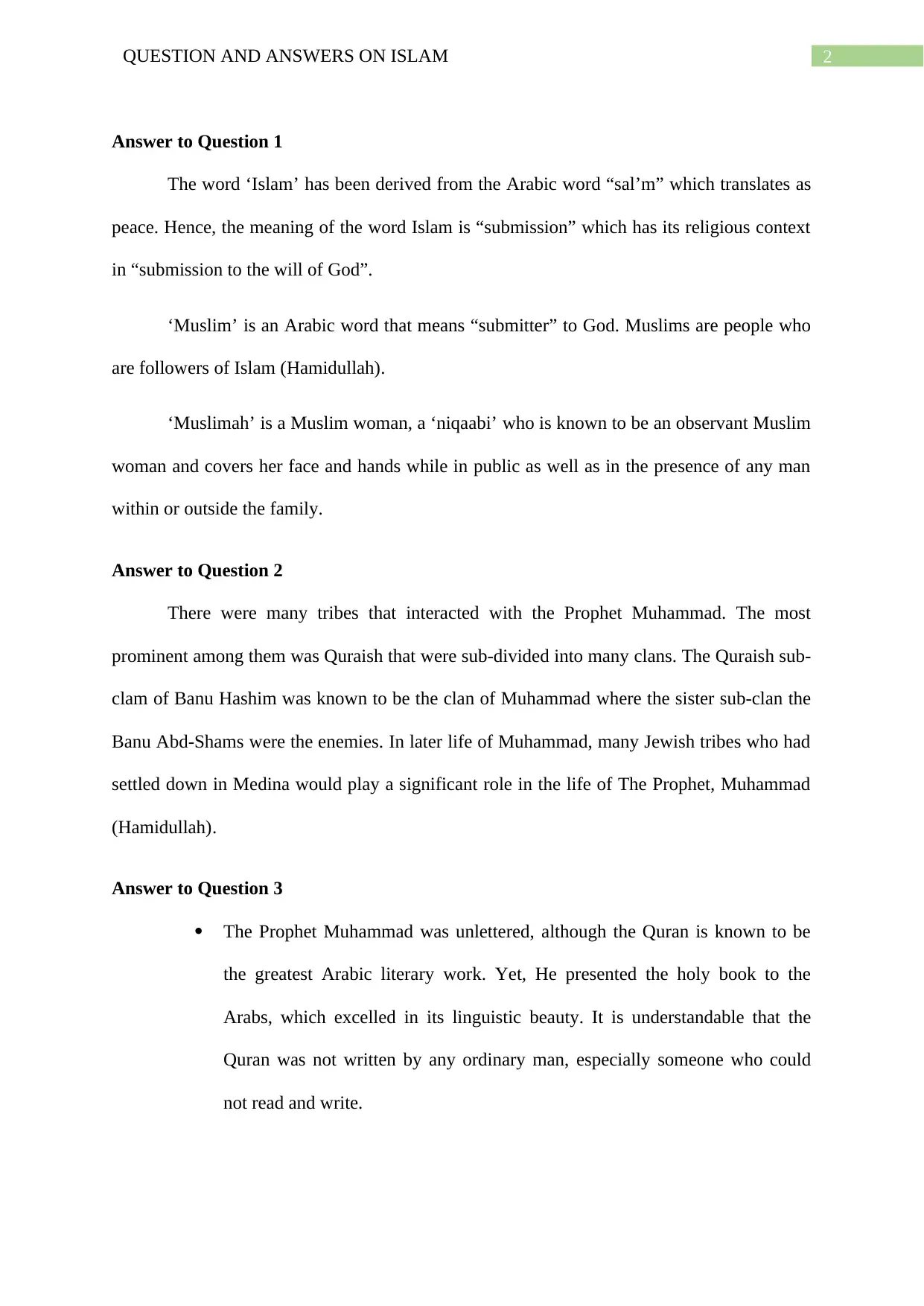
2QUESTION AND ANSWERS ON ISLAM
Answer to Question 1
The word ‘Islam’ has been derived from the Arabic word “sal’m” which translates as
peace. Hence, the meaning of the word Islam is “submission” which has its religious context
in “submission to the will of God”.
‘Muslim’ is an Arabic word that means “submitter” to God. Muslims are people who
are followers of Islam (Hamidullah).
‘Muslimah’ is a Muslim woman, a ‘niqaabi’ who is known to be an observant Muslim
woman and covers her face and hands while in public as well as in the presence of any man
within or outside the family.
Answer to Question 2
There were many tribes that interacted with the Prophet Muhammad. The most
prominent among them was Quraish that were sub-divided into many clans. The Quraish sub-
clam of Banu Hashim was known to be the clan of Muhammad where the sister sub-clan the
Banu Abd-Shams were the enemies. In later life of Muhammad, many Jewish tribes who had
settled down in Medina would play a significant role in the life of The Prophet, Muhammad
(Hamidullah).
Answer to Question 3
The Prophet Muhammad was unlettered, although the Quran is known to be
the greatest Arabic literary work. Yet, He presented the holy book to the
Arabs, which excelled in its linguistic beauty. It is understandable that the
Quran was not written by any ordinary man, especially someone who could
not read and write.
Answer to Question 1
The word ‘Islam’ has been derived from the Arabic word “sal’m” which translates as
peace. Hence, the meaning of the word Islam is “submission” which has its religious context
in “submission to the will of God”.
‘Muslim’ is an Arabic word that means “submitter” to God. Muslims are people who
are followers of Islam (Hamidullah).
‘Muslimah’ is a Muslim woman, a ‘niqaabi’ who is known to be an observant Muslim
woman and covers her face and hands while in public as well as in the presence of any man
within or outside the family.
Answer to Question 2
There were many tribes that interacted with the Prophet Muhammad. The most
prominent among them was Quraish that were sub-divided into many clans. The Quraish sub-
clam of Banu Hashim was known to be the clan of Muhammad where the sister sub-clan the
Banu Abd-Shams were the enemies. In later life of Muhammad, many Jewish tribes who had
settled down in Medina would play a significant role in the life of The Prophet, Muhammad
(Hamidullah).
Answer to Question 3
The Prophet Muhammad was unlettered, although the Quran is known to be
the greatest Arabic literary work. Yet, He presented the holy book to the
Arabs, which excelled in its linguistic beauty. It is understandable that the
Quran was not written by any ordinary man, especially someone who could
not read and write.
⊘ This is a preview!⊘
Do you want full access?
Subscribe today to unlock all pages.

Trusted by 1+ million students worldwide
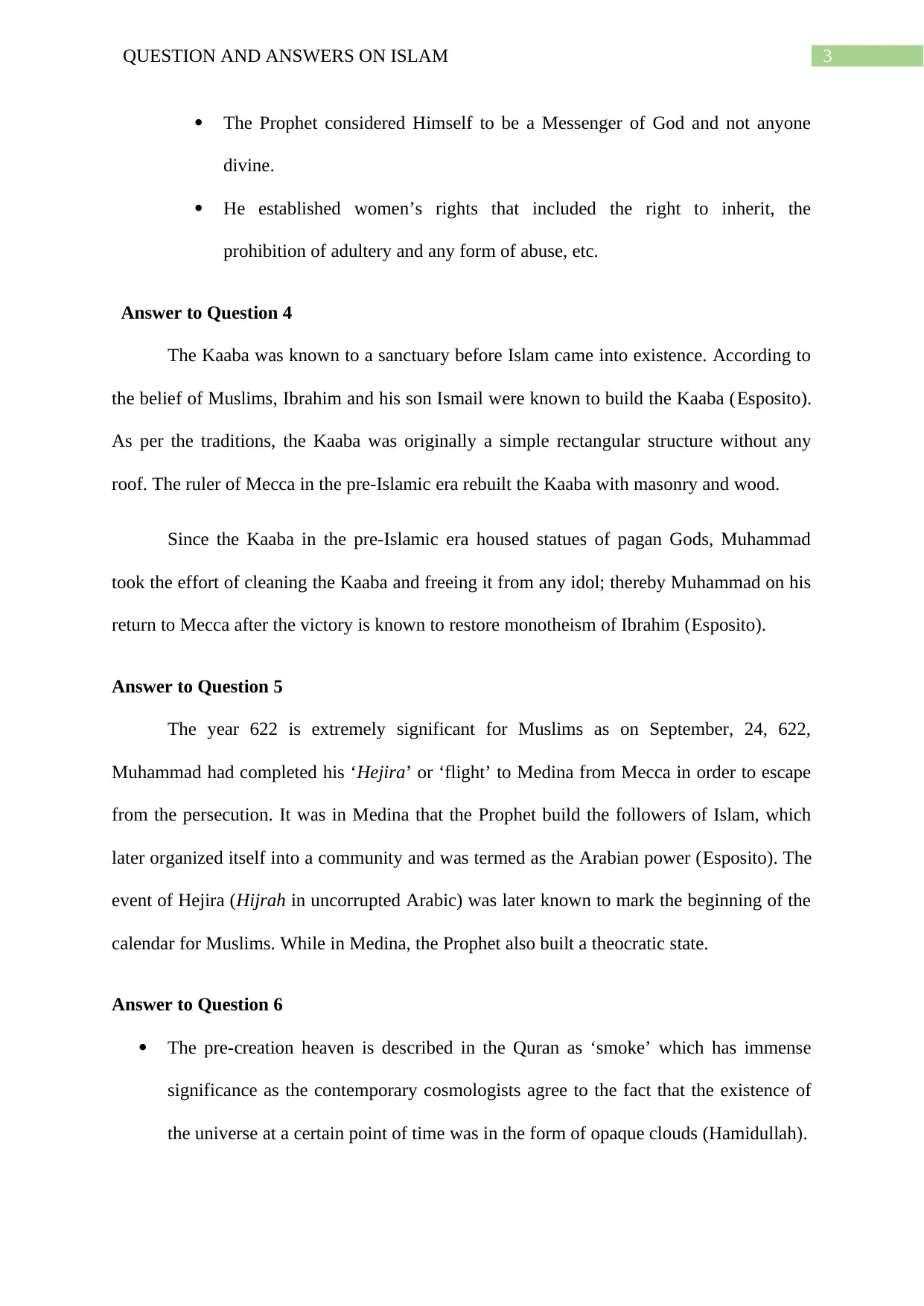
3QUESTION AND ANSWERS ON ISLAM
The Prophet considered Himself to be a Messenger of God and not anyone
divine.
He established women’s rights that included the right to inherit, the
prohibition of adultery and any form of abuse, etc.
Answer to Question 4
The Kaaba was known to a sanctuary before Islam came into existence. According to
the belief of Muslims, Ibrahim and his son Ismail were known to build the Kaaba (Esposito).
As per the traditions, the Kaaba was originally a simple rectangular structure without any
roof. The ruler of Mecca in the pre-Islamic era rebuilt the Kaaba with masonry and wood.
Since the Kaaba in the pre-Islamic era housed statues of pagan Gods, Muhammad
took the effort of cleaning the Kaaba and freeing it from any idol; thereby Muhammad on his
return to Mecca after the victory is known to restore monotheism of Ibrahim (Esposito).
Answer to Question 5
The year 622 is extremely significant for Muslims as on September, 24, 622,
Muhammad had completed his ‘Hejira’ or ‘flight’ to Medina from Mecca in order to escape
from the persecution. It was in Medina that the Prophet build the followers of Islam, which
later organized itself into a community and was termed as the Arabian power (Esposito). The
event of Hejira (Hijrah in uncorrupted Arabic) was later known to mark the beginning of the
calendar for Muslims. While in Medina, the Prophet also built a theocratic state.
Answer to Question 6
The pre-creation heaven is described in the Quran as ‘smoke’ which has immense
significance as the contemporary cosmologists agree to the fact that the existence of
the universe at a certain point of time was in the form of opaque clouds (Hamidullah).
The Prophet considered Himself to be a Messenger of God and not anyone
divine.
He established women’s rights that included the right to inherit, the
prohibition of adultery and any form of abuse, etc.
Answer to Question 4
The Kaaba was known to a sanctuary before Islam came into existence. According to
the belief of Muslims, Ibrahim and his son Ismail were known to build the Kaaba (Esposito).
As per the traditions, the Kaaba was originally a simple rectangular structure without any
roof. The ruler of Mecca in the pre-Islamic era rebuilt the Kaaba with masonry and wood.
Since the Kaaba in the pre-Islamic era housed statues of pagan Gods, Muhammad
took the effort of cleaning the Kaaba and freeing it from any idol; thereby Muhammad on his
return to Mecca after the victory is known to restore monotheism of Ibrahim (Esposito).
Answer to Question 5
The year 622 is extremely significant for Muslims as on September, 24, 622,
Muhammad had completed his ‘Hejira’ or ‘flight’ to Medina from Mecca in order to escape
from the persecution. It was in Medina that the Prophet build the followers of Islam, which
later organized itself into a community and was termed as the Arabian power (Esposito). The
event of Hejira (Hijrah in uncorrupted Arabic) was later known to mark the beginning of the
calendar for Muslims. While in Medina, the Prophet also built a theocratic state.
Answer to Question 6
The pre-creation heaven is described in the Quran as ‘smoke’ which has immense
significance as the contemporary cosmologists agree to the fact that the existence of
the universe at a certain point of time was in the form of opaque clouds (Hamidullah).
Paraphrase This Document
Need a fresh take? Get an instant paraphrase of this document with our AI Paraphraser
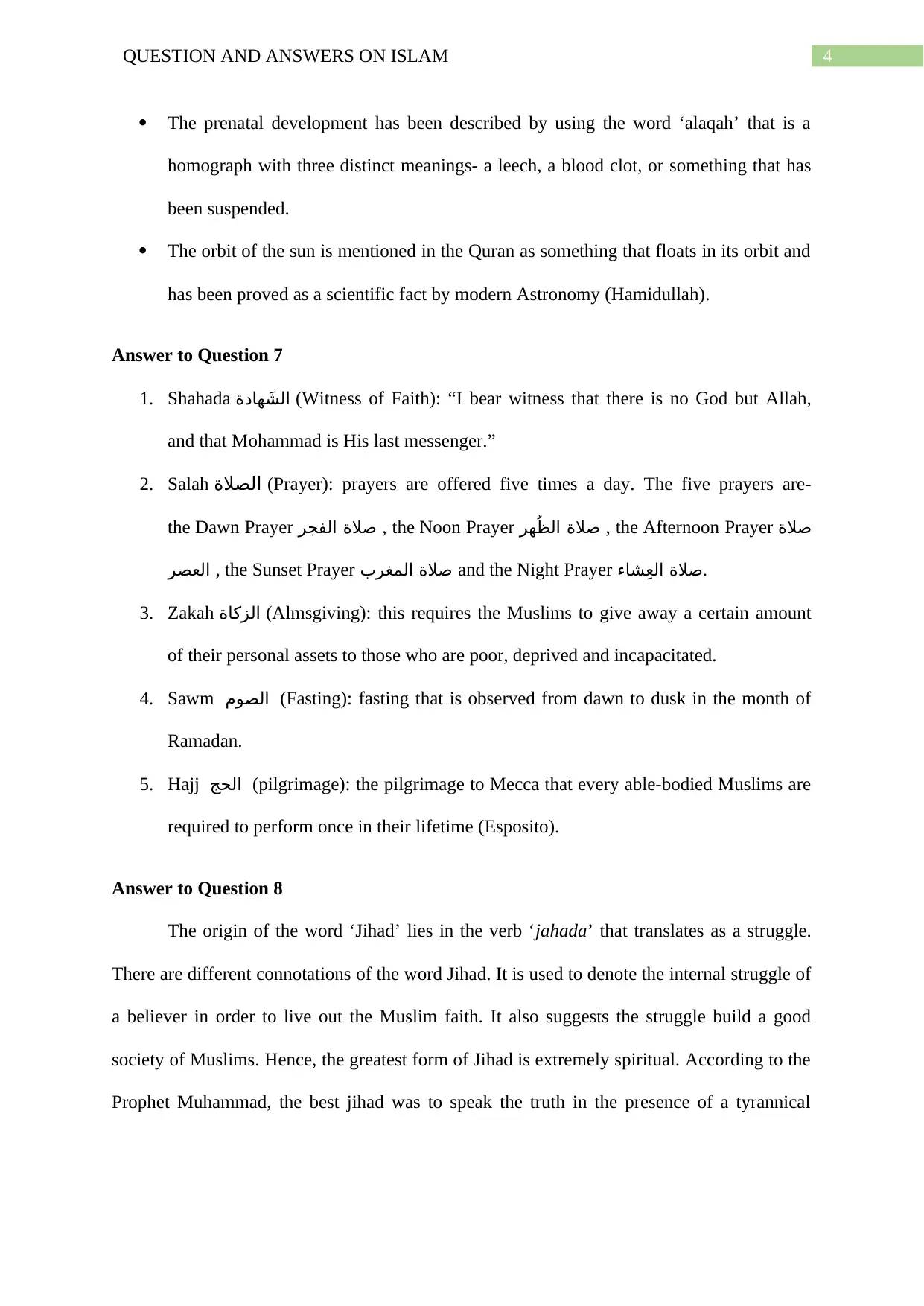
4QUESTION AND ANSWERS ON ISLAM
The prenatal development has been described by using the word ‘alaqah’ that is a
homograph with three distinct meanings- a leech, a blood clot, or something that has
been suspended.
The orbit of the sun is mentioned in the Quran as something that floats in its orbit and
has been proved as a scientific fact by modern Astronomy (Hamidullah).
Answer to Question 7
1. Shahada الشَهادة (Witness of Faith): “I bear witness that there is no God but Allah,
and that Mohammad is His last messenger.”
2. Salah الصالة (Prayer): prayers are offered five times a day. The five prayers are-
the Dawn Prayer صالة الفجر , the Noon Prayer صالة الظُهر , the Afternoon Prayer صالة
العصر , the Sunset Prayer صالة المغرب and the Night Prayer صالة العِشاء.
3. Zakah الزكاة (Almsgiving): this requires the Muslims to give away a certain amount
of their personal assets to those who are poor, deprived and incapacitated.
4. Sawm الصوم (Fasting): fasting that is observed from dawn to dusk in the month of
Ramadan.
5. Hajj الحج (pilgrimage): the pilgrimage to Mecca that every able-bodied Muslims are
required to perform once in their lifetime (Esposito).
Answer to Question 8
The origin of the word ‘Jihad’ lies in the verb ‘jahada’ that translates as a struggle.
There are different connotations of the word Jihad. It is used to denote the internal struggle of
a believer in order to live out the Muslim faith. It also suggests the struggle build a good
society of Muslims. Hence, the greatest form of Jihad is extremely spiritual. According to the
Prophet Muhammad, the best jihad was to speak the truth in the presence of a tyrannical
The prenatal development has been described by using the word ‘alaqah’ that is a
homograph with three distinct meanings- a leech, a blood clot, or something that has
been suspended.
The orbit of the sun is mentioned in the Quran as something that floats in its orbit and
has been proved as a scientific fact by modern Astronomy (Hamidullah).
Answer to Question 7
1. Shahada الشَهادة (Witness of Faith): “I bear witness that there is no God but Allah,
and that Mohammad is His last messenger.”
2. Salah الصالة (Prayer): prayers are offered five times a day. The five prayers are-
the Dawn Prayer صالة الفجر , the Noon Prayer صالة الظُهر , the Afternoon Prayer صالة
العصر , the Sunset Prayer صالة المغرب and the Night Prayer صالة العِشاء.
3. Zakah الزكاة (Almsgiving): this requires the Muslims to give away a certain amount
of their personal assets to those who are poor, deprived and incapacitated.
4. Sawm الصوم (Fasting): fasting that is observed from dawn to dusk in the month of
Ramadan.
5. Hajj الحج (pilgrimage): the pilgrimage to Mecca that every able-bodied Muslims are
required to perform once in their lifetime (Esposito).
Answer to Question 8
The origin of the word ‘Jihad’ lies in the verb ‘jahada’ that translates as a struggle.
There are different connotations of the word Jihad. It is used to denote the internal struggle of
a believer in order to live out the Muslim faith. It also suggests the struggle build a good
society of Muslims. Hence, the greatest form of Jihad is extremely spiritual. According to the
Prophet Muhammad, the best jihad was to speak the truth in the presence of a tyrannical
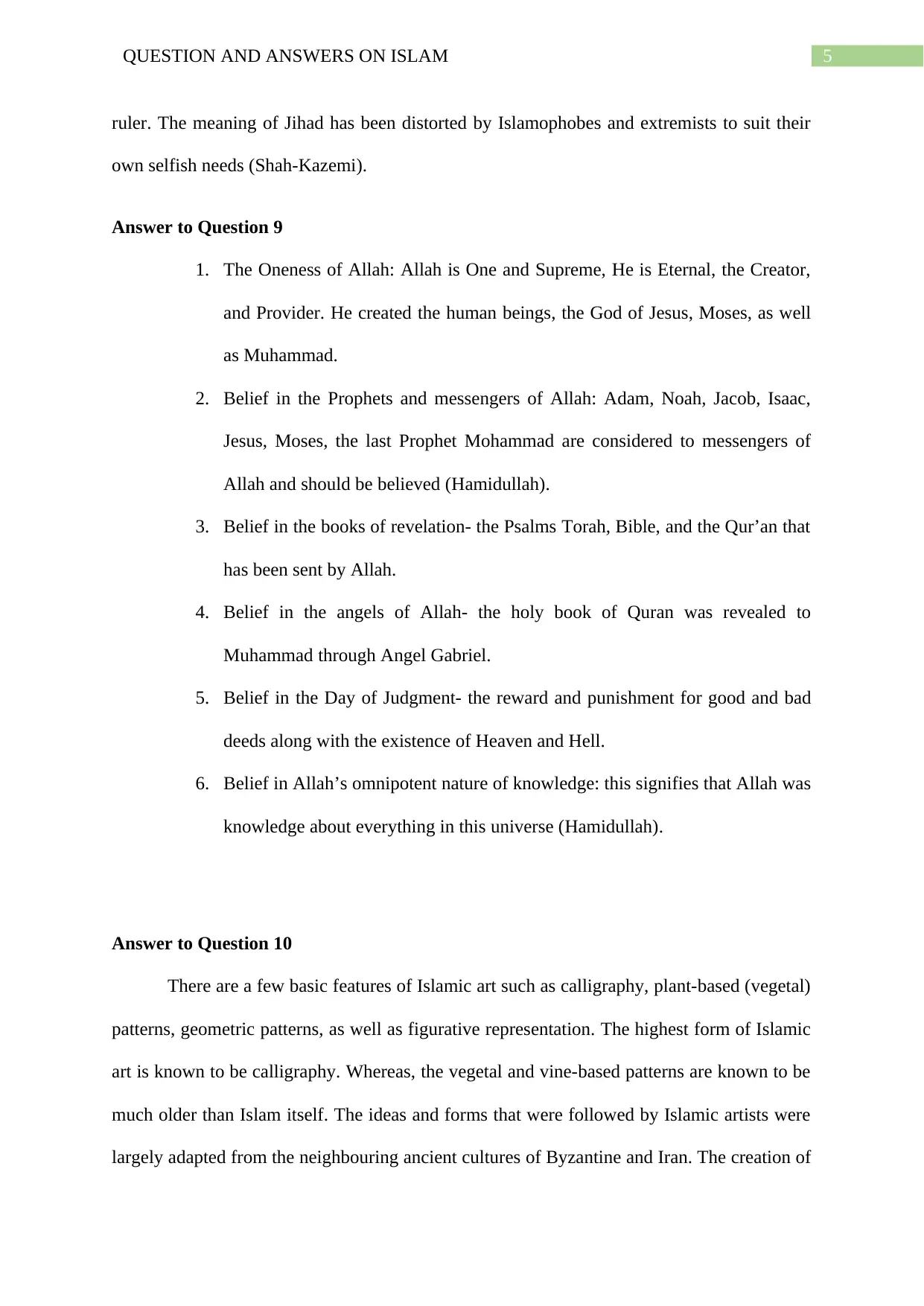
5QUESTION AND ANSWERS ON ISLAM
ruler. The meaning of Jihad has been distorted by Islamophobes and extremists to suit their
own selfish needs (Shah-Kazemi).
Answer to Question 9
1. The Oneness of Allah: Allah is One and Supreme, He is Eternal, the Creator,
and Provider. He created the human beings, the God of Jesus, Moses, as well
as Muhammad.
2. Belief in the Prophets and messengers of Allah: Adam, Noah, Jacob, Isaac,
Jesus, Moses, the last Prophet Mohammad are considered to messengers of
Allah and should be believed (Hamidullah).
3. Belief in the books of revelation- the Psalms Torah, Bible, and the Qur’an that
has been sent by Allah.
4. Belief in the angels of Allah- the holy book of Quran was revealed to
Muhammad through Angel Gabriel.
5. Belief in the Day of Judgment- the reward and punishment for good and bad
deeds along with the existence of Heaven and Hell.
6. Belief in Allah’s omnipotent nature of knowledge: this signifies that Allah was
knowledge about everything in this universe (Hamidullah).
Answer to Question 10
There are a few basic features of Islamic art such as calligraphy, plant-based (vegetal)
patterns, geometric patterns, as well as figurative representation. The highest form of Islamic
art is known to be calligraphy. Whereas, the vegetal and vine-based patterns are known to be
much older than Islam itself. The ideas and forms that were followed by Islamic artists were
largely adapted from the neighbouring ancient cultures of Byzantine and Iran. The creation of
ruler. The meaning of Jihad has been distorted by Islamophobes and extremists to suit their
own selfish needs (Shah-Kazemi).
Answer to Question 9
1. The Oneness of Allah: Allah is One and Supreme, He is Eternal, the Creator,
and Provider. He created the human beings, the God of Jesus, Moses, as well
as Muhammad.
2. Belief in the Prophets and messengers of Allah: Adam, Noah, Jacob, Isaac,
Jesus, Moses, the last Prophet Mohammad are considered to messengers of
Allah and should be believed (Hamidullah).
3. Belief in the books of revelation- the Psalms Torah, Bible, and the Qur’an that
has been sent by Allah.
4. Belief in the angels of Allah- the holy book of Quran was revealed to
Muhammad through Angel Gabriel.
5. Belief in the Day of Judgment- the reward and punishment for good and bad
deeds along with the existence of Heaven and Hell.
6. Belief in Allah’s omnipotent nature of knowledge: this signifies that Allah was
knowledge about everything in this universe (Hamidullah).
Answer to Question 10
There are a few basic features of Islamic art such as calligraphy, plant-based (vegetal)
patterns, geometric patterns, as well as figurative representation. The highest form of Islamic
art is known to be calligraphy. Whereas, the vegetal and vine-based patterns are known to be
much older than Islam itself. The ideas and forms that were followed by Islamic artists were
largely adapted from the neighbouring ancient cultures of Byzantine and Iran. The creation of
⊘ This is a preview!⊘
Do you want full access?
Subscribe today to unlock all pages.

Trusted by 1+ million students worldwide
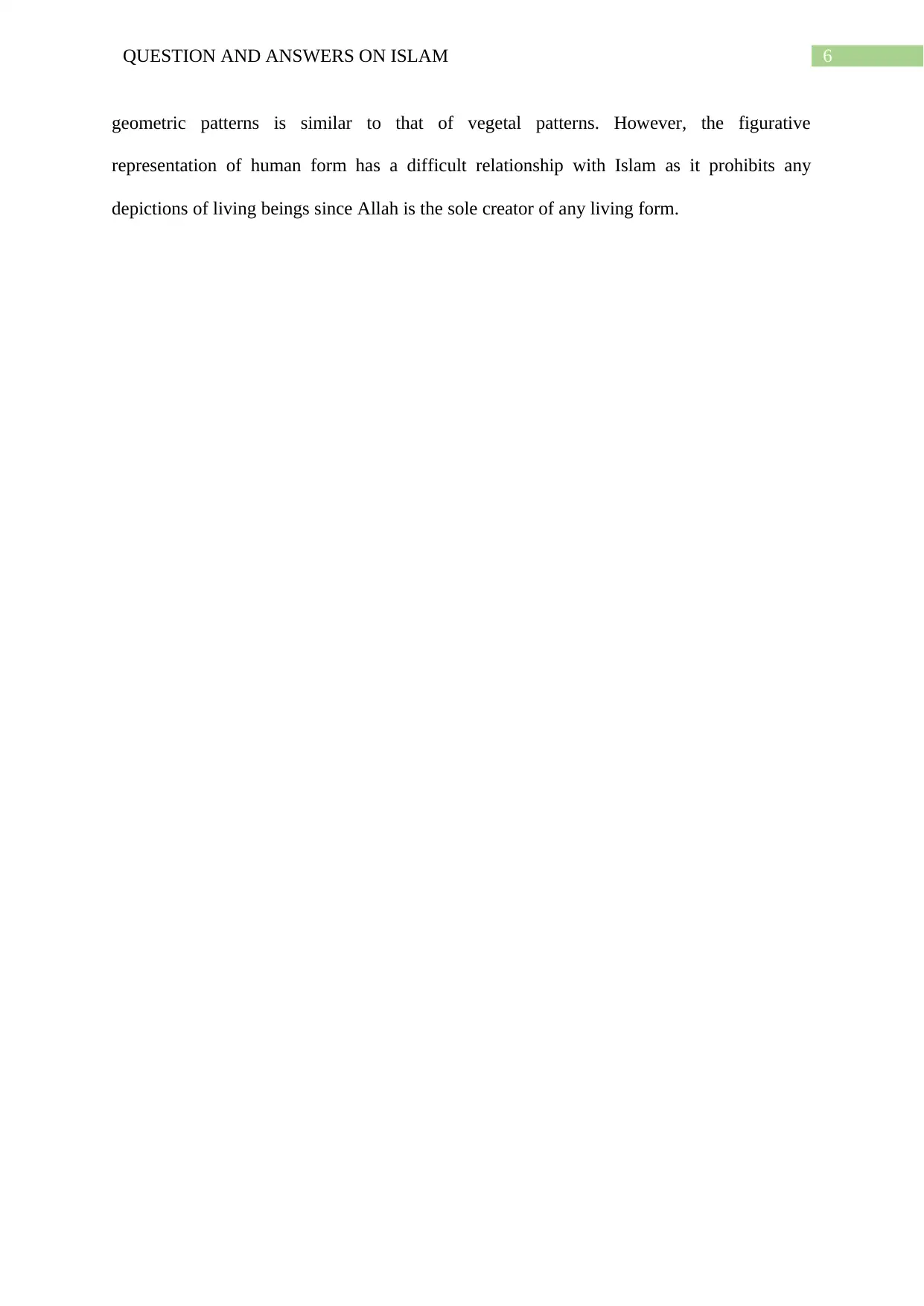
6QUESTION AND ANSWERS ON ISLAM
geometric patterns is similar to that of vegetal patterns. However, the figurative
representation of human form has a difficult relationship with Islam as it prohibits any
depictions of living beings since Allah is the sole creator of any living form.
geometric patterns is similar to that of vegetal patterns. However, the figurative
representation of human form has a difficult relationship with Islam as it prohibits any
depictions of living beings since Allah is the sole creator of any living form.
Paraphrase This Document
Need a fresh take? Get an instant paraphrase of this document with our AI Paraphraser
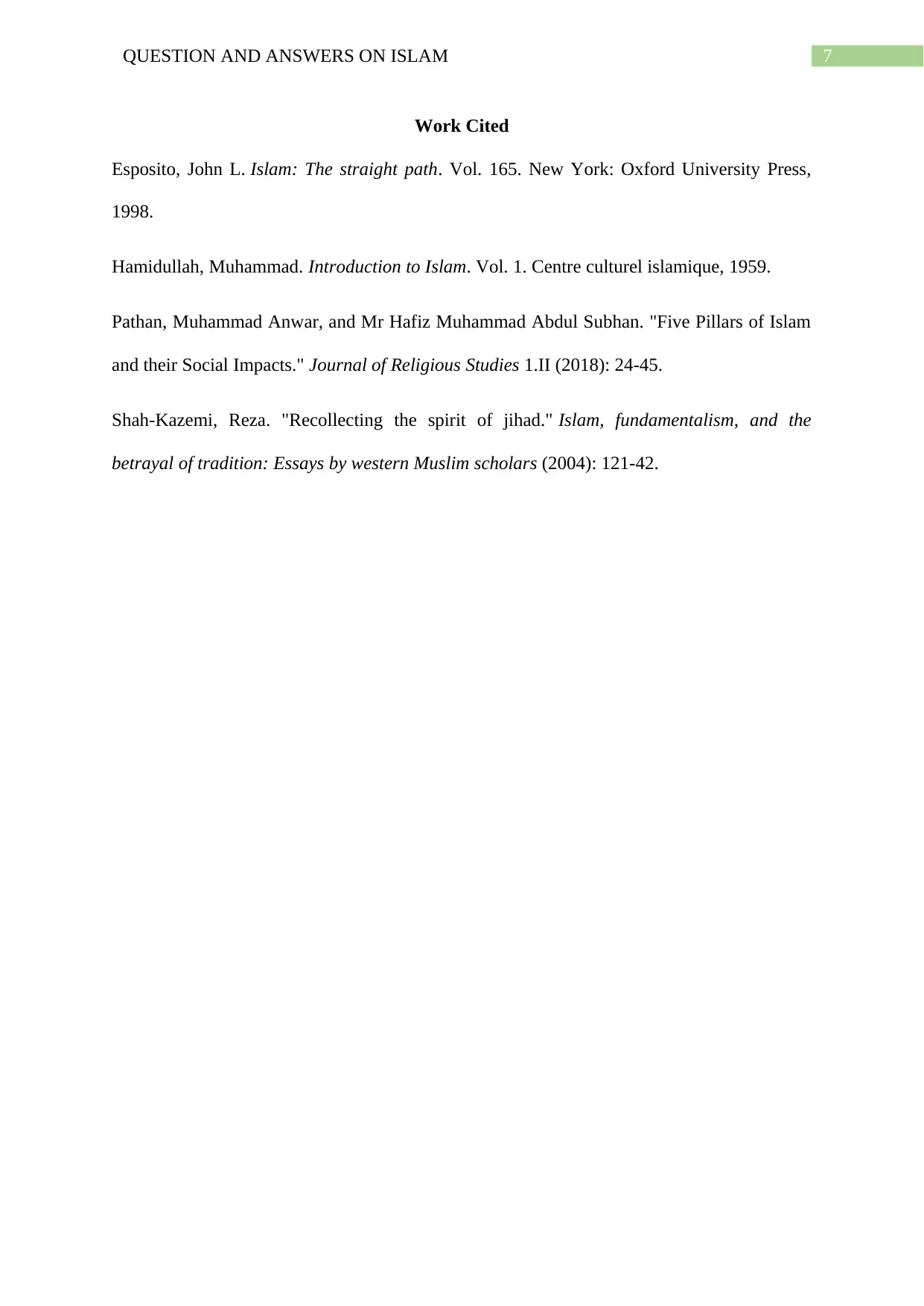
7QUESTION AND ANSWERS ON ISLAM
Work Cited
Esposito, John L. Islam: The straight path. Vol. 165. New York: Oxford University Press,
1998.
Hamidullah, Muhammad. Introduction to Islam. Vol. 1. Centre culturel islamique, 1959.
Pathan, Muhammad Anwar, and Mr Hafiz Muhammad Abdul Subhan. "Five Pillars of Islam
and their Social Impacts." Journal of Religious Studies 1.II (2018): 24-45.
Shah-Kazemi, Reza. "Recollecting the spirit of jihad." Islam, fundamentalism, and the
betrayal of tradition: Essays by western Muslim scholars (2004): 121-42.
Work Cited
Esposito, John L. Islam: The straight path. Vol. 165. New York: Oxford University Press,
1998.
Hamidullah, Muhammad. Introduction to Islam. Vol. 1. Centre culturel islamique, 1959.
Pathan, Muhammad Anwar, and Mr Hafiz Muhammad Abdul Subhan. "Five Pillars of Islam
and their Social Impacts." Journal of Religious Studies 1.II (2018): 24-45.
Shah-Kazemi, Reza. "Recollecting the spirit of jihad." Islam, fundamentalism, and the
betrayal of tradition: Essays by western Muslim scholars (2004): 121-42.
1 out of 8
Related Documents
Your All-in-One AI-Powered Toolkit for Academic Success.
+13062052269
info@desklib.com
Available 24*7 on WhatsApp / Email
![[object Object]](/_next/static/media/star-bottom.7253800d.svg)
Unlock your academic potential
Copyright © 2020–2025 A2Z Services. All Rights Reserved. Developed and managed by ZUCOL.




